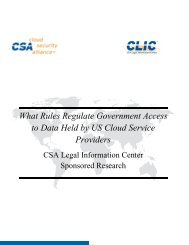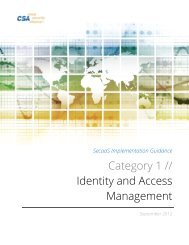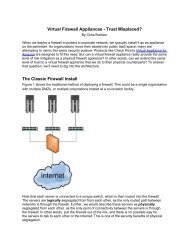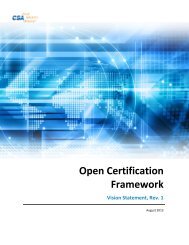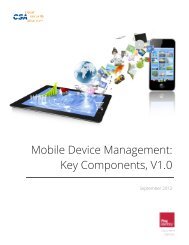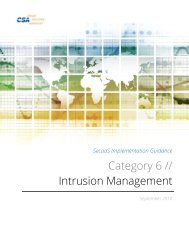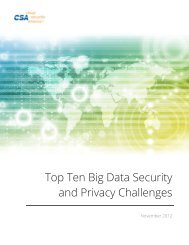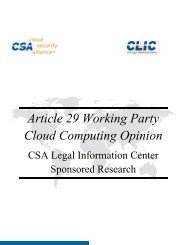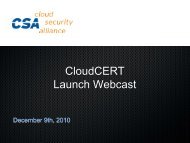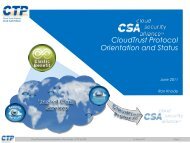Email Security Implementation Guidance - Cloud Security Alliance
Email Security Implementation Guidance - Cloud Security Alliance
Email Security Implementation Guidance - Cloud Security Alliance
- No tags were found...
You also want an ePaper? Increase the reach of your titles
YUMPU automatically turns print PDFs into web optimized ePapers that Google loves.
CLOUD SECURITY ALLIANCE SecaaS <strong>Implementation</strong> <strong>Guidance</strong>, Category 4: <strong>Email</strong> <strong>Security</strong>• Reporting – Allows the customer to have visibility into their mail flow. Also provides the tools neededby customer administrators to trace or search for email messages as part of their support workflow.• Encryption – The process of transforming information (plaintext) using an algorithm (cipher) to make itunreadable to anyone except those possessing special knowledge, usually referred to as a key. Solutionsexist for encryption of data at-rest, in-use and in-transit of all email messages & attachments.Encryption keys should be retained by the organization and not the cloud provider.• Archiving and Preservation – A systematic approach to saving and protecting the data contained inemail messages so it can be accessed quickly at a later date.• Business Continuity and Disaster Recovery – Services that enhance an organization’s ability to recoverfrom a disaster and/or unexpected event, and resume or continue operations.4.2 <strong>Guidance</strong> and <strong>Implementation</strong> StepsThe security of the overall email system, whether fully outsourced or enterprise hosted and augmented withsecurity services, is driven first by securing the individual components to industry standards and organizationalpolicy.4.2.1 Client <strong>Security</strong>In order to provide appropriate security measures, a cloud-based provider should offer, at a minimum, thefollowing security mechanisms:• End-point Encryption – Starting with the general user interface or access, ensure the end point deliveryis secured via encryption protocols.• <strong>Security</strong> Protocols – Mail clients use industry standard protocols to access email such as POP3 andIMAP. Encrypted versions of these protocols (POP3S and IMAPS) use Transport Layer <strong>Security</strong> (TLS, alsocall SSL3) which allows for session negotiation of encryption algorithm and length of key. Negotiationoptions can be limited on the server side and should be configured to prevent use of weak keys or olderalgorithms.• Encrypted Protocols – When using a web-based UI, it is important that HTTP traffic use TLS (i.e., HTTPS).• Encrypted API Protocol – An Ajax style web UI may access server APIs, so APIs must be accessed usingHTTPS as well.• Session Timeouts – User sessions should have session timeouts that limit access to data.• Usage Policies – Users should be advised against the use of email on public computers such as airportkiosks or public libraries, as message text or login information may be cached on such machines.Recommend users avoid these computers altogether, or not open or download sensitive emails. As aminimal requirement, they should log out when finished.4.2.1.1 Mobile DevicesMobile devices such as tablets and smart cell phones have other security problems. While they are veryconvenient and allow 24/7 access to email, their design presents difficulties for the email administrator.Because they are carried on a person, there are physical security issues. The user’s password is saved on the© Copyright 2012, <strong>Cloud</strong> <strong>Security</strong> <strong>Alliance</strong>. All rights reserved. 22




